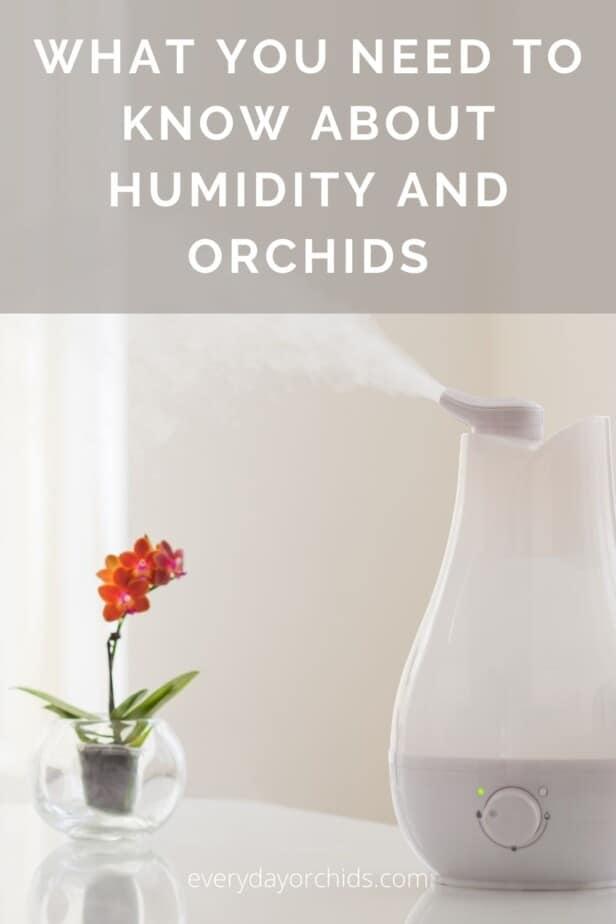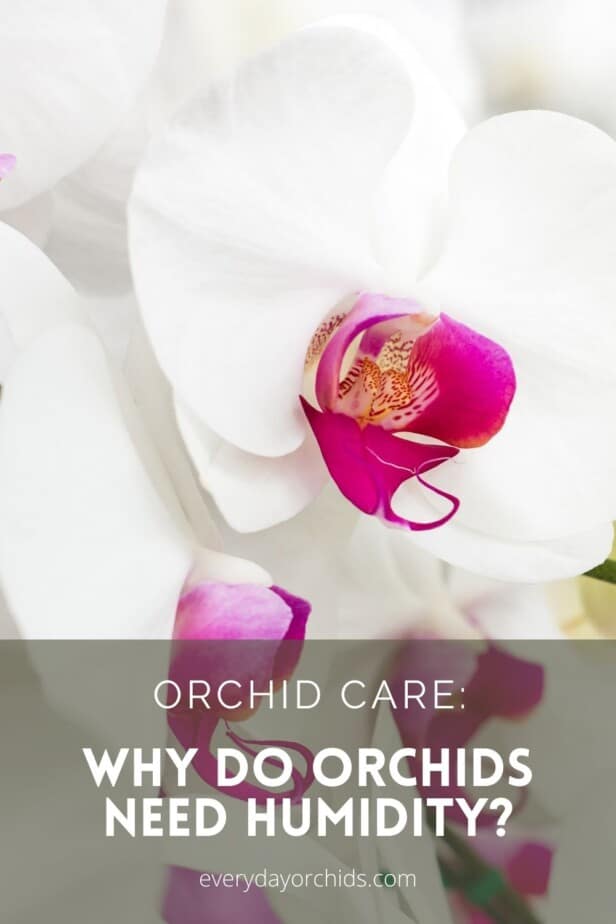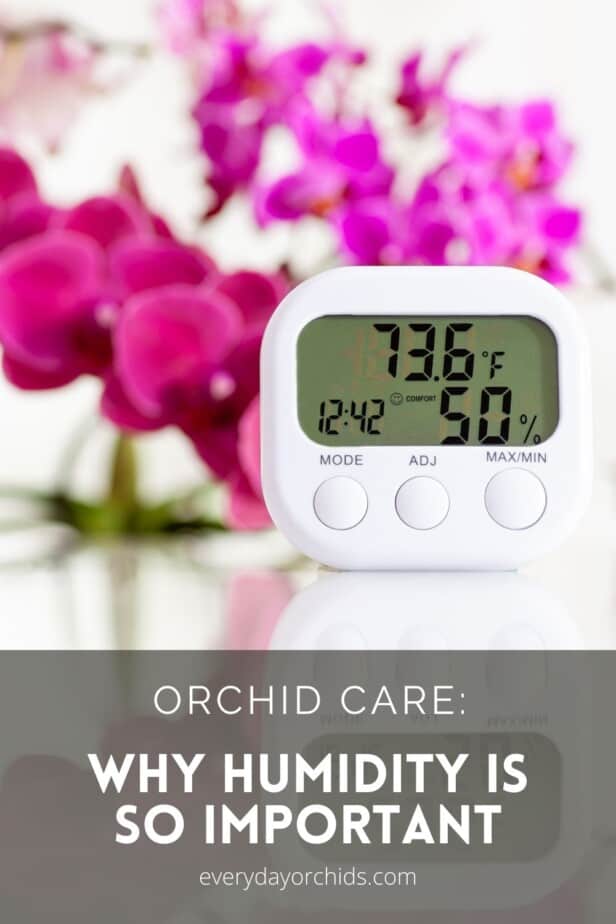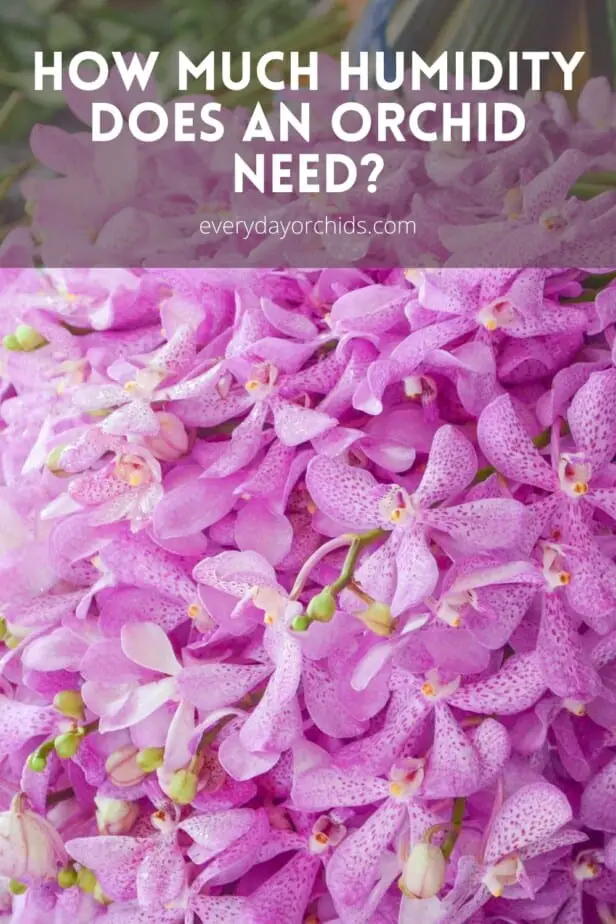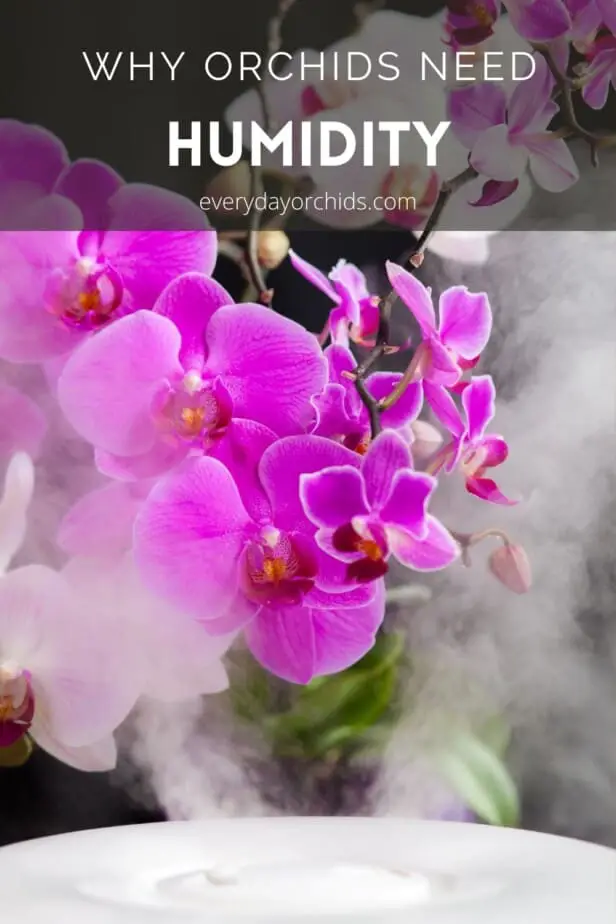We have all heard of the need to maintain a certain humidity level for orchids. But, why is humidity so important for orchids? I’ll answer that question and more below.
Along with temperature, watering, and lighting, you will need to keep an eye on humidity levels to ensure your orchids really thrive.
Humidity is important for growth and flowering in orchids. Adequate humidity provides the orchid with extra moisture and helps make up for the water they lose during normal gas exchange. Most orchids do well with humidity levels ranging from 40 to 70%. Humidity levels can make the difference between an orchid who merely gets along and a robust, healthy, growing orchid.

Humidity levels are one of the key things to track and consider when growing orchids. Keep reading to learn more about why orchids need humidity to survive. Plus, I’ll go over humidity ranges for the most popular orchid species and how to measure humidity levels in your home.
Please note that these links are affiliate links and as an Amazon Associate, I earn from qualifying purchases. Purchases made through affiliate links in this post may generate commissions at no additional cost to you. Use this link for a discounted Amazon Prime trial. Thank you for your support!
Table of Contents
Why Do Orchids Need Humidity?

First things first. Why do orchids need a certain level of humidity to survive? Well, the most basic answer is that humidity replaces the moisture orchids lose during gas exchange.
Every plant, including orchids, have stomata on their leaves. These stomata allows the orchid to perform gas exchange. When the stomata open, the plants release oxygen into the air and take in carbon dioxide.
This gas exchange is generally what people refer to when they say “plants clean the air around us.” It is also an important part of photosynthesis and energy harvesting for plants.
However, every time the stomata open, they also lose a bit of moisture. This happens to a greater extent when surrounding humidity levels are low and the air is dry.
When there are adequate levels of humidity around your orchid, it is able to absorb moisture throughout the day. This helps make up for the moisture losses that occur when the stomata open.
Maintaining humidity around your orchids helps counteract moisture loss and keeps your orchid from drying out.
Coupled with proper watering and care, adequate humidity levels around your orchid result in smooth, firm, healthy-looking leaves. Orchid roots will be plump, firm and have green tips, a sign of health and growth. With the right amount of humidity and proper care, your orchid will be thriving and flowering each season.
What Happens to an Orchid if There Isn’t Enough Humidity?
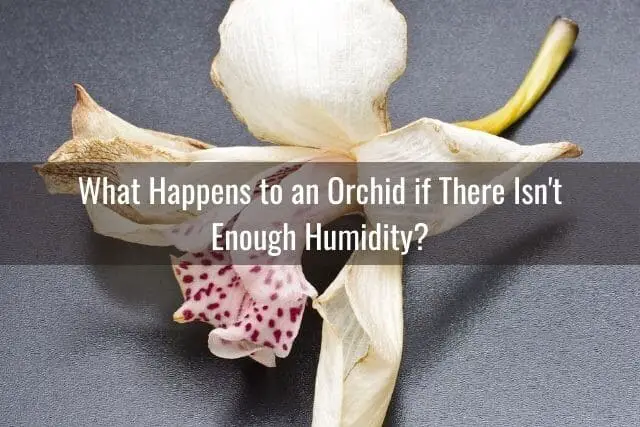
If humidity levels are very low, the plant responds by opening its stomata less often. This is the plant’s way to try and prevent moisture loss.
When this happens, there is less gas exchange. The plant has less carbon dioxide available for use in its basic functions.
If the orchid continues to open its stomata less and less often in an attempt to preserve moisture, growth slows down noticeably. If there isn’t enough humidity around your orchids, you will see slower, stunted growth.
Low humidity levels negatively affect orchid flowering and the health of orchid leaves and roots.
As a result of the moisture lost through the orchid leaves and foliage, orchid leaves may start to wilt, shrivel, or become limp. There is a higher chance of this happening if your orchid is also not absorbing enough water through the root system.
Low humidity levels also result in early flower loss and deformed, misshapen orchid blooms. Orchid roots, especially aerial roots, will be wrinkled, gray, and dry-looking.
Worst case scenario, if nothing is done to address this problem, the orchid will eventually die. Don’t let this happen to you! Below, I’ll talk about some ways you can easily monitor and raise humidity for your orchids.
Orchid Humidity Requirements
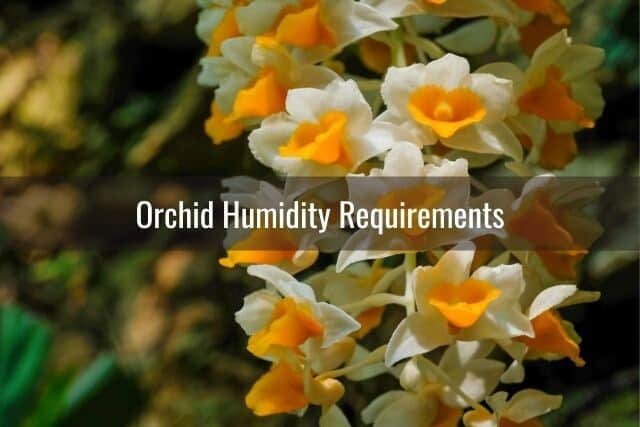
In general, many orchids will do well with humidity levels between 40-70%. Some orchids require higher humidity levels, while others prefer lower levels. If you aren’t sure what kind of orchid you have, just aim for a humidity level right in the middle of the range.
Below, I’ll give some examples of orchids that do well in low humidity settings, and orchids that prefer high humidity settings.
Orchids That Prefer Low Humidity Levels
In many homes, a comfortable humidity level for us humans is around 30-50%. This can get tricky if you are trying to provide your orchids with the right amount of humidity at the same time. The answer to this problem? Grow orchids that prefer lower humidity levels.
Orchids that will do well with lower humidity levels (30-60%) include Phalaenopsis, Laelia, Oncidium, Zygopetalum and Paphiopedilum orchids.
Specifically, Phalaenopsis orchids prefer humidity levels around 50%. These orchids are among the most popular orchids for beginner growers. Aside from a couple of simple interventions to manage humidity levels, there is little extra that you will need to do to maintain adequate humidity for your orchids.
Oncidiums prefer humidity levels between 30-60%.
Cymbidium orchids like humidity levels that range between 40-60%.
Laelia orchids prefer humidity to be around 50%.
Paphiopedilum Lady Slipper orchids do well with a humidity range of 40-50%.
Zygopetalum orchids are less common, but are also considered to be low humidity orchids. They prefer humidity levels of about 40-60%.
Orchids That Prefer High Humidity Levels
Some popular orchid species do better with high humidity levels ranging up to 80%. This can be difficult to achieve without humidifiers or a greenhouse, which I will talk about more below. But first, the orchids:
Cattleya orchids prefer humidity levels between 50-80%.
Dendrobium orchids, specifically the hard cane versions, and Epidendrum orchids do better when humidity is between 50-80%.
Miltoniopsis orchids need humidity levels between 50-70%.
Vanda orchids require 80% humidity levels. This, coupled with their notoriously long roots, makes it more challenging to grow Vandas in a house (though not impossible).
However, a greenhouse setting might be best for growing Vanda orchids. In a greenhouse, you can hang the Vanda and allow room for the roots to freely grow, all while maintaining high humidity levels.
Bulbophylum orchids, which are known for their scents, require 70-90% humidity levels.
Other orchids, such as the monkey-faced Dracula orchids, or the Pescatoria coelestis, which reside in the cloud-covered forests of South America, require high humidity levels as well.
As you can see, there is quite a range of humidity levels that an orchid needs in order to grow and thrive. Their humidity requirements will match what they would normally receive in their natural growing conditions.
I have just touched on a few of the most popular species. There are thousands of orchid species in existence. If you have an orchid that is not listed above, definitely do your research and learn about its specific growing needs.
How To Measure Humidity Around Your Orchids
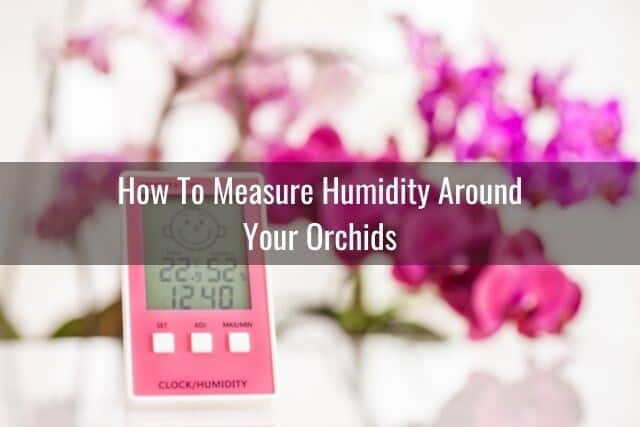
While you may be able to get an idea of how high or low humidity levels are in the home just by “feel,” this is hardly accurate. To get a more accurate sense of the humidity levels in your home, or in your orchid growing area, use a humidity sensor. This is also known as a hygrometer.
These handy devices are relatively inexpensive and are a must-have for every orchid grower. After all, it is impossible to know the precise humidity levels without it.
Many hygrometers have a temperature gauge as well. This allows you to see, at a glance, both the temperature and humidity levels around your orchids at any given time. You will be able to make adjustments as necessary.
Here are some popular and highly-rated hygrometers available:
- AcuRite Digital Hygrometer & Indoor Thermometer. This hygrometer records daily highs and lows, allowing you to look back and track the daily temperature and humidity ranges your orchids were exposed to. It uses one AA battery (not included).
- ThermoPro Digital Hygrometer Indoor Thermometer and Humidity Gauge. This handy little hygrometer also records daily highs and lows and allows you to track the day’s ranges. It uses a AAA battery, which is included.
- ThermoPro Digital Mini Hygrometer Thermometer. This is a smaller version of the above hygrometer and is well-liked by reviewers. It comes with an AAA battery. Its smaller size allows you to use this in your humidity box or greenhouse.
- Goabroa Mini Hygrometer Thermometer. This is a basic, no frills hygrometer/thermometer combination. It displays the temperature and humidity levels in a digital LCD display and uses one lithium battery (included). Unlike the other hygrometers listed above, this one only reads temperatures in Fahrenheit. Its small footprint allows it to work well in a humidity box, terrarium, or small setting.
How Can I Increase Humidity Around My Orchids?
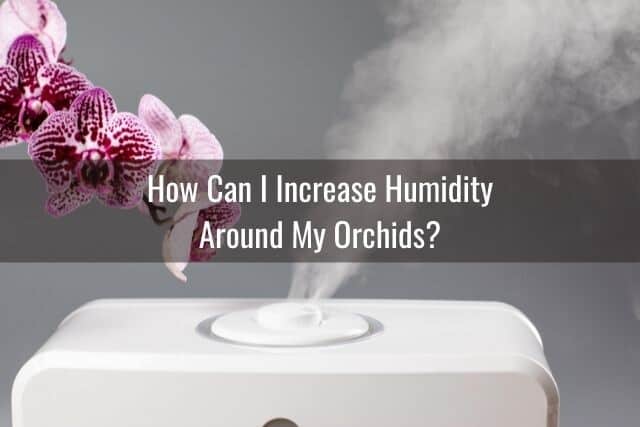
Most of us care for orchids indoors, where the humidity levels are relatively low, compared to an orchid’s native habitat. In many cases, we will need to use different methods and tools to increase humidity around our orchids. Here are the most popular ways you can increase humidity around your orchids:
- Use a humidifier
- Place your orchid pots on a humidity tray
- Place your orchids in a terrarium or a greenhouse
- Use a humidity dome
- Use a humidity box
I go over the different ways you can increase humidity around your orchid in more detail in another article. Please check out that resource by clicking the blue link.
Preventing Problems Related to High Humidity

While we want to provide the best growing environment for our orchids, at the same time, we want to give ourselves a good living environment too. When humidity levels exceed 50% in the home, it can start to feel uncomfortable, sticky and stuffy.
What’s more concerning is that at higher humidity levels, mold growth can occur. You may start to see condensation on the windows and the walls may feel damp. Overtime, this constant exposure to moisture can lead to mildew, damage to the drywall, and structural rot.
So, how do you balance maintaining humidity for your orchids with healthy living? Here are some ways:
Make Sure There is Adequate Airflow
Air movement around your orchids and in the room is key for preventing mold growth in and around your orchids. Gentle airflow around the plants will help keep moisture from collecting on orchid leaves.
Air circulation will also help remove excess water from the potting media after watering. It prevents damp stagnant air from collecting around your plants.
Good airflow around your orchids also mimics the air movement orchids would experience in their native environment.
Depending on how many orchids you have and where you keep them, you can maintain airflow around your orchids in several ways.
Open a Window
The easiest and most cost-effective method would be to open a window in the room. Make sure your orchids are not exposed to cold drafts or strong breezes. Some orchid growers leave their windows partially open during the day to provide air circulation for their plants, then close them at night.
Use a Fan
Another option would be to use a fan. If you have a small collection of orchids, a small desk fan placed nearby would work.
Put the fan on the lowest setting and avoid pointing the fan directly at the orchids. Remember, you are just trying to circulate the air in the growing area.
If you have a humidity box, humidity dome or some other type of enclosed space, you can get a battery operated rechargeable mini fan. Set it in a corner of your humidity box and run it on the lowest setting. This will help ensure that the high humid conditions of a humidity box or dome do not inadvertently lead to mold and pathogen growth.
If you have a larger orchid collection, or orchids spread out throughout a room, you can invest in an oscillating tower fan or a stand fan. These fans have various settings that you can adjust to your preferences. Many newer fans also include timers and remotes. I would recommend using the lowest setting and having it oscillate.
Keep in mind though, that airflow can be detrimental if humidity levels are low. Air movement, coupled with low humidity levels, reduces humidity further and will dry up the plant.
So before you set up a fan or open a window, make sure your orchid has adequate humidity levels to keep it from drying out.
Final Thoughts
Providing and maintaining good humidity levels for your orchid is essential for proper orchid care. It can make a big difference in an orchid’s growth and bloom production.
If you are new to orchid growing, start with the basics. Get a hygrometer and find out what your indoor humidity levels currently are.
Also, figure out what kind of orchid you have. As I mentioned above, most orchids do well with humidity levels ranging from 40-70%. Certain orchid species can get by with lower levels, while other species really need high humidity levels in order to survive. I gave some humidity ranges for the most popular orchid species above, and you can use this as a general guide.
There are a variety of ways you can increase and improve indoor humidity for your orchids. Check out the methods outlined above and pick the one that works best for you and your orchids.
Indoor humidity levels become more of a concern as we move into fall and winter and the air becomes drier. If you are interested in learning more about seasonal orchid care, please check out my articles about how to care for orchids in the fall, and winter orchid care.
Thanks for reading! Happy orchid growing!
If you enjoyed this article, please pin it and share!
